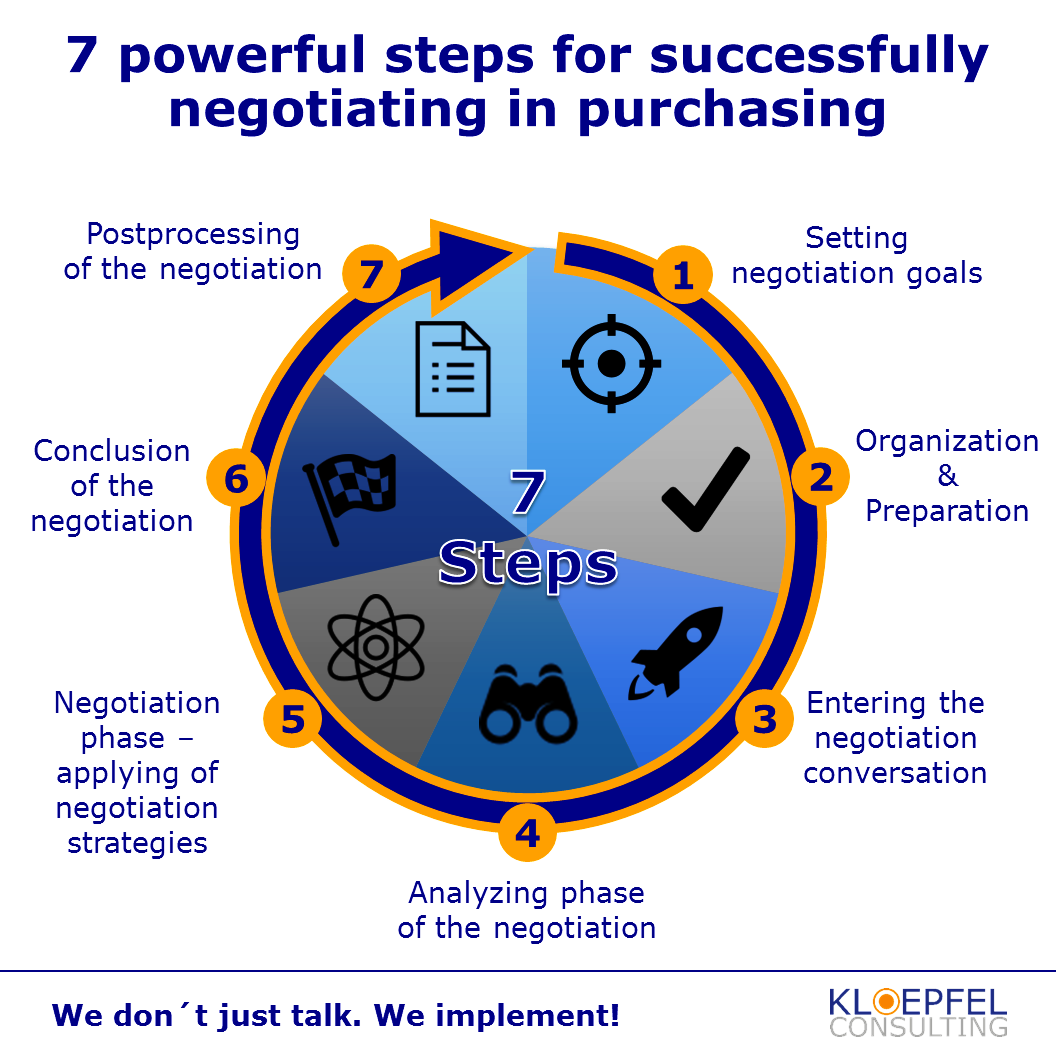The 7 most effective tips for successful negotiation in purchasing
Negotiations in purchasing and logistics
Negotiation is one of the most used and decisive tools for buyers. A strategically successful negotiation can promise huge costs or welcomed savings. Savings in purchasing usually go hand in hand with a higher profit margin and a stronger competitive position. In the following guidebook article you can read about 7 effective tips that can make your next negotiation a great success.
1. Set negotiating goals and increase motivation
Purchasing and procurement have a great potential to increase sales and profits of a company. For example, in the German automotive industry, one percent savings in material and material overhead costs have the same effect on profits as an increase in sales of 20%. Of course, this lever varies from company to company and between different industries. However, it can be stated that a professional negotiation with suppliers as well as a purchasing optimization and a good supply chain management can create true return treasures. Therefore it is really important to be well-trained as a buyer and to go to a negotiation with the right strategy. This can for e.g. be trained in advance with a purchasing consultancy.
If you have recognized how decisive your position for the company is and how much you can achieve, then the motivation to realize it should appear.
The first step in preparing for a negotiation is the setting of goals. These can guide you through the entire negotiation process and give you support, even in difficult situations.
First, the desired goal should be formulated in concrete terms. In a second step, it is very helpful to visualize the situation in which you want to achieve your goals. For example, how a supplier agrees to a cost saving of 2%. This image reinforces the motivation to achieve this goal and acts like a magnet. The next step should be the planning of the individual stages that are necessary to reach the desired goals. At the end, a minimum and a maximum goal should be defined. After that the actual implementation of the content-related preparation for the upcoming negotiation and the goals that are to be achieved in it begins. This is crucial to be able to optimize supplier management and the purchasing process. It may include ABC analyzes or market surveys among other tools.
2. The organizational preparation
A systematic and field-tested approach to being well prepared at every stage of the negotiation process is the 7-phase model. It includes the phases: preparation, entry and contact, analysis, negotiation, result, exit and follow-up.
Experienced buyers say that good preparation decides to 80% about the success of a negotiation. Thus, it can be concluded that the harder the upcoming negotiation will be, the more thorough the preparation should be.
As the basis for a successful and effective negotiation, it is important to create the best possible initial situation. So the location where the negotiation takes place should also be perfect. It happens often that seemingly trivial factors such as a meeting room that is not reserved on time, the lack of documents or a refusal of technology, become real “negotiation killers”. At this point, meeting rooms become a figurehead of the company and, accordingly, it is worthwhile making them as pleasant as possible and throwing a good light on the company through certificates or reports.
Another measure to ensure the smoothest possible conduct of a negotiation is the creation of a structured agenda. In this way, misunderstandings can be avoided right from the beginning and all participants have the same level of knowledge about the course of the upcoming negotiation.
The next important step is to occupy oneself with the actual negotiating partner, often the supplier. Information about the company as well as references, customers and distribution policy helps to get an exact picture of the counterpart. If the person (s) with whom the negotiation is being conducted is/ are also known one should make an accurate picture of them as well. (Business) Social networks give plenty of opportunity here. In this way, the negotiating partner can be better assessed and, ideally, weaknesses and strengths can be recognized. It is also important to know the intentions and goals of the opposite in order to have arguments against them.
In addition to the focus on the negotiating partner, the internal communication and the appearance of the negotiating team, if there is one, should be perfectly coordinated. Only a few other things can shake up one’s own basis for negotiation in such a way as contradictory statements of one’s own employees do. Each participant should be aware of the general tactics, goals and his own role in the negotiation. So it is necessary to appoint a negotiator who can lead the whole team even in difficult situations.
Of course, your own preparation should also be carried out thoroughly. All documents should be available and the own appearance should also be in accordance with the negotiation situation. Because only when everyone in the team feels well prepared, this radiance can be transferred to other parties, which in turn benefits the general negotiation atmosphere.
3. Start of the negotiation
As a basis for a harmonious negotiation, the factual level and the relationship level of the conversation should always be considered separately. Both parties have goals and occasions that form the content for the factual level. However, there are still people negotiating with each other, which inevitably lead to peculiarity, prejudices and bias. This relationship between the negotiating partners in the negotiation should be as positive as possible in order to ensure a productive negotiation. This is only possible if there is mutual appreciation and respect. In addition to the opposite, one’s own person should be appreciated.
At the beginning there is a friendly and open greeting which signals your own hospitality to the negotiating partner. After that comes a round of small talk to relax the atmosphere and to create a pleasant base for the following negotiation. The beginning of the business part starts with discussing the agenda, the goals for the day and all other organizational circumstances. There are several tips to make the entry into the negotiation successful. Among other things, it is advisable to put more emphasis on the relationship level at the beginning of the negotiations. Thus, the own appreciation for the interlocutor and his concerns should not be neglected. It can be shown through open and positive body language as well as a positive word choice. In addition, the guest should be given more time to talk at the beginning. At this point active listening is very valuable.
4. Analysis phase of the negotiation
When it comes to the actual factual part of the negotiation, the respective expectations of the participants should be discussed at the beginning in order to create a common basis. Here it is also relevant to find out to what extent the other party has prepared for their own company and possibly their own offer. In this phase, insights about the negotiating partner and his negotiating strategy can be gained, which may be important in the further course of the negotiation. This includes for e.g the way of speaking or his substantive understanding of the subject. It should also be paid attention to gestures and facial expressions. The listener has always the advantage that he can record what was said up to four times faster than the person can pronounce it. This gives the necessary wiggle room to pay attention not only to the content but also to non-verbal communication. This is important as more than 90% of the communication is non-verbal. Furthermore, the supplier’s offer should be analyzed. It is an advantage to also illuminate the conditions such as delivery times, etc. In case of uncertainties, it is advisable to ask clear comprehension questions. At the end of the analysis it is advisable, as a purchaser, to summarize the most important facts for everyone once again.
Especially at the beginning of the negotiation, the right questions are an important instrument to lead the conversation. Of course, this also applies to the entire negotiation. That is why there are proven types of questions with which desired behavior or phrases in a conversation can be caused.
| Question type | Example | Purpose |
|---|---|---|
| Selection question | Can we expect your offer by tomorrow or will you make it today? | With this question type you help to make the decision easier |
| Opening question | What are your special performance characteristics? | Requires an informational goal and oblige to listen. |
| Probing question | Do you also work according to the principle of the extended workbench? | To find out what experience the supplier has. |
| Problem question | What do you do when it comes to supply bottlenecks? | Should mark problem areas of the supplier. |
| Specifying questions | What does that exactly mean according to our cooperation? | Helps to bring clarity to the understanding and educates the seller. |
| Tag question | Is punctual payment beneficial to you? | Verifies a statement and contributes to the formation of consensus. |
| Justification question | So that I can get an impression of your company, would you please allow me a few questions? | I clarify why I ask so that the partner understands the intention. |
| Blockade runner | Seller: That does not work for us. Buyer: Imagine that would work what then? | The thought patterns of the partner should be dissolved; the question should give a thought-provoking impulse. |
Source: Helmut Wannenwetsch 2013, Erfolgreiche Verhandlungsführung in Einkauf und Logistik
5. Negotiation phase – utilization of negotiation strategies
In the actual negotiation phase, it is decisive to apply the right negotiation strategy. On the one hand, it should fit to the negotiating partner and his position in the negotiation, and on the other hand should achieve the desired result.
Often there is an imbalance in the power of the negotiating parties. Thus, for example, the supplier can have a strong bargaining power because he is a monopolist for his product or service. On the other hand, the buyer can also take a powerful position due to large volumes that he wants to receive. Such a power position is an important lever to enforce owns goals in the negotiation.
It is also possible that there are no rational convincing arguments ot that the supplier is a monopolist. In such a case, the only option is to convince the negotiating partner at the relationship level. At this point it is important that the negotiating partner receives a particularly friendly treatment and to provide him with personal amenities. This can be for e.g. exclusive factory tours or highlighting the particularly good cooperation. It is also necessary to constantly improve the relationship with the monopolist.
As already mentioned, it depends on the individual situation or the framework conditions, which negotiation strategy is the most expedient. Because of that there are many strategic approaches for negotiation. Almost every time a combination of individual strategy elements is the best choice for a successful negotiation result. In the following, several relevant strategies are discussed:
Enforcement strategy:
In the enforcement strategy, a negotiating party has almost always an advantage and thus a better negotiation position. This position is used by the party to enforce their demands or negotiating goals. Usually, this procedure ends in a price war, which can quickly lead to the end of the price negotiation and therefore makes both sides losers. Because of that, this methodology is rather discouraged because in addition the relationship with the negotiating partner suffers and thus no sustainable business relationship can arise.
Defensive strategy:
The defensive strategy is designed to make short-term compromises with long-term benefits. Thus, desires and goals are not enforced like come hell or high water, but one partly agrees on goals of the opponent. Through this a relationship of trust can be established, which often pays off in the future. However, this strategy should not be chosen because of a pure inclination for harmony, since the own party is otherwise exploited.
Compromise strategy:
Similarly to the defensive strategy is the compromise strategy. But here, everyone waives of a slice of the cake and the negotiation partners meet in the middle. So a result can be achieved, which is not optimal, but at least exists.
Win-win strategy:
Another known strategy is the so-called win-win or winner-winner situation. For this strategy, the prerequisite is often that both negotiating partners are equal and are interested in a long-term cooperation. Both have negotiation options and are prepared to respond to each other. All parties generate profits through the business relationship, which makes them lasting and sustainable.
Bogeyman strategy:
A strategy which is also frequently occurring in negotiations is to give up the responsibility or decision-making power. Through this the decision is passed to the supervisor, in critical areas such as price negotiations. In case of doubt, a final decision may be postponed and, for example, time may be gained for further research, but this procedure almost always reduces one’s own competence in relation to the negotiating partner. This usually means a disadvantage for future negotiations. Due to that, critical lower or upper limits should be clarified in advance.
If-then-strategy:
Moreover, the if-then negotiation technique can be used because it is popular and effective at the same time. In this approach, demands and benefits are linked. In a first step, the willingness to cooperate with the negotiating partner is promised. If this is accepted, another claim can be realized. For example, you can ask for an additional service of the supplier, which will provide him additional revenue (if). At the same time, the demand for a discount for the basic service can be cited (then).
6. Conclusion of the negotiation
When all the arguments and counter arguments are exchanged and all positions are negotiated, it is important to keep them in a log and to reach a common conclusion. In order to avoid misunderstandings, all topics discussed should be compared shortly. Then if these continue to exist, it may happen that individual issues need to be renegotiated again. In addition, each party will receive an overall picture of their own agreements to be fulfilled by the negotiating partner.
At the end of the negotiation phase, it is important to end it positively. This means to separate the relationship level from the factual level and to appreciate the negotiating partner even if negotiations have not been successful. This approach is particularly important if a long-term relationship with the business partner shall be established. A mutual feedback to the negotiation talk can help to optimize future discussions. Likewise, as with the greeting, personal issues should be addressed when saying good bye to the negotiating partner. In this way the basis for the next meeting is created.
7. Follow-up of the negotiation
In addition to creating an insightful log, a to-do list should also be compiled for the upcoming tasks with the responsible persons as well as deadlines. It is also important to evaluate own negotiation performance as well as the performance of the team. It is useful to compare the measurable goals with the results achieved so that one can see what worked out and which factors were responsible for the success or failure of certain negotiating items. Only who knows why he was successful, can reproduce this in future negotiations. The clean follow-up is the foundation for a promising preparation of the next negotiation.
Previously, you read 7 effective tips that will help you make your negotiations even more profitable. A strategic approach to negotiation may be effort, but it will pays off. We hope that this article will help you to generate savings in your next negotiation.
Author: Osman Cetinkaya




Comments are closed.